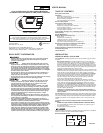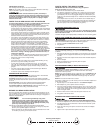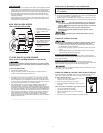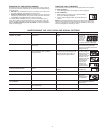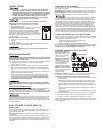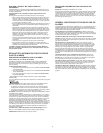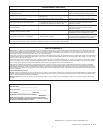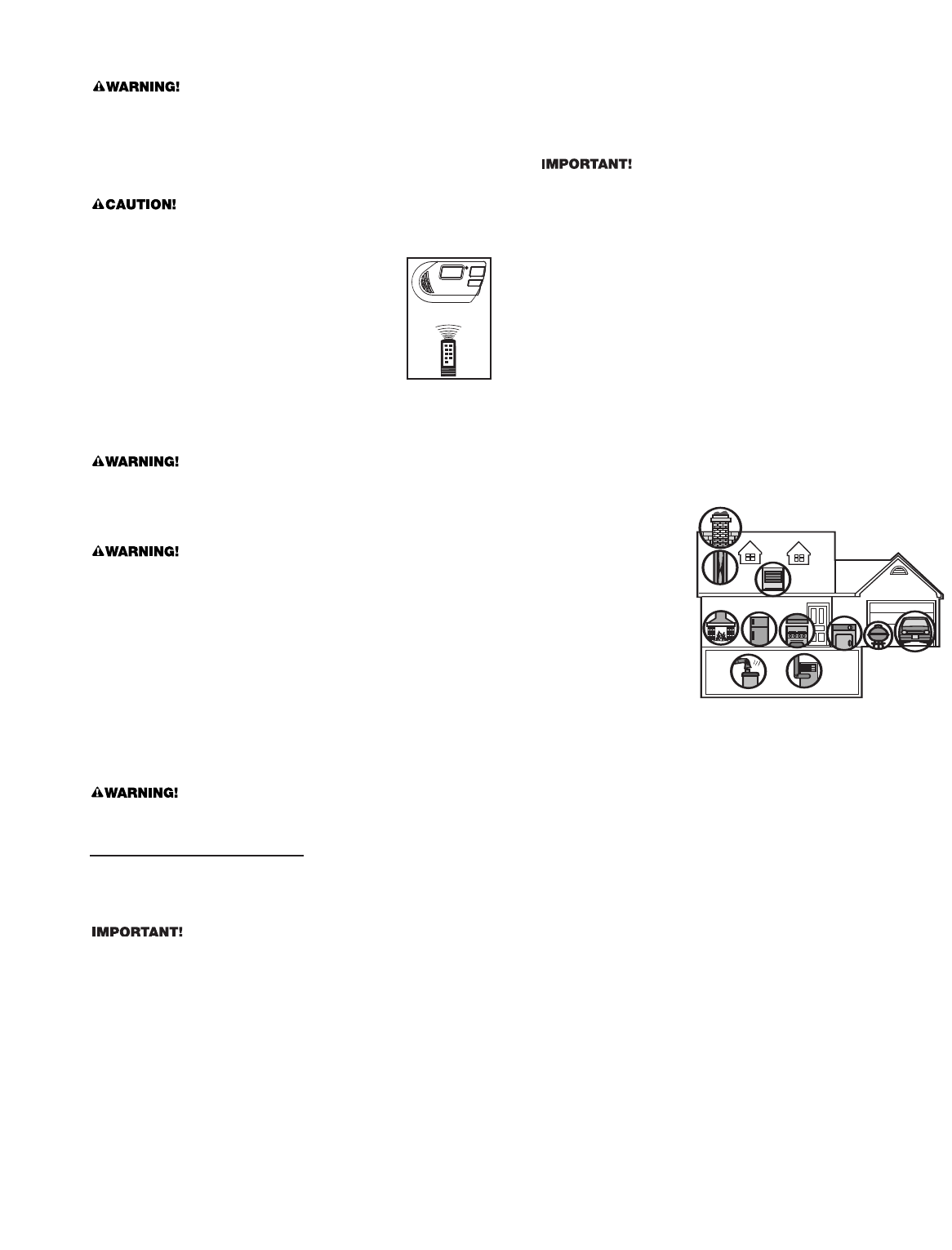
5
WEEKLY TESTING
• NEVER use an open flame of any kind to test this unit. You might
accidentally damage or set fire to the unit or to your home.The
bui
lt-in test switch accurately tests the unit’s operation as required
by Underwriters Laboratories, Inc. (UL). NEVER use vehicle exhaust!
Exhaust may cause permanent damage and voids your warranty.
•
DO NOT stand close to the Alarm when the horn is sounding.
Ex
posure at close range may be harmful to your hearing.When
testing, step away when horn starts sounding.
I
t is important to test this unit every week to make sure it is working
pr
operly.
Y
ou can test this Gas/CO Alarm two ways:
1. Manually: Press the Test/Silence button on the Alarm
co
ver until alarm sounds.
2
.
R
emote Control:
Ai
m your remote control at the Alarm
and press the CHANNEL or VOLUME button.
During testing, you will hear a loud, repeating horn pattern:
1
beep every second, while the Red LED flashes and the
display shows “GAS”. Then you will hear a loud, repeating
horn pattern: 4 beeps, pause, 4 beeps, pause, while the Red
L
ED flashes and the display shows “CO” with an increasing
CO ppm number.
If the Alarm does not test properly:
1. Make sure the AC power is applied and battery is fresh and installed
corr
ectly.
2
.
Test the unit again.
I
f t
he Alarm is still not working properly, replace it immediately. Refer to the
“Limited Warranty” at the end of this manual.
If there is s
till a problem, do not try to fix the Alarm yourself.This will
void your warranty!
REGULAR MAINTENANCE
Use only the replacement batteries listed below.The unit may not operate
properly with other batteries. Never use rechargeable batteries since they
may not provide a constant charge.
This unit has been designed to be as maintenance-free as possible, but there
are a few simple things you must do to keep it working properly:
• Test it at least once a week.
• Clean the Alarm at least once a month; gently vacuum the outside of the
Alarm using your household vacuum’s soft brush attachment.Test the
Alarm. Never use water, cleaners or solvents since they may damage the
unit.
• Relocate the unit if it sounds frequent unwanted alarms. See “Where This
Alarm Should Not Be Installed” for details.
• When the battery back-up becomes weak, the Alarm will “chirp” about
once a minute (the low battery warning).You should replace the battery
immediately to continue your protection.
This Alarm must have AC or
battery power to operate. If AC power fails, and the battery is dead
or missing, the Alarm cannot operate.
DO NOT spray cleaning chemicals or insect sprays directly on or near the
Al
arm
.
DO NOT paint over the Alarm. Doing so may permanently damage the
Al
arm
.
CHOOSING A REPLACEMENT BATTERY:
Your Alarm requires one standard 9V alkaline battery. The following batteries
are acceptable as replacements: Duracell #MN1604, (Ultra) #MX1604;
Eveready (Energizer) #522. You may also use a Lithium battery like the Ultralife
U9VL-J for longer service life between battery changes. These batteries are
a
v
ai
lable at many local retail stores.
Act
ua
l b
a
tt
e
r
y se
rvice life depends on the Alarm and the environment in which
it is i
nstalled. All the batteries specified above are acceptable replacement
batteries for this unit. Regardless of the manufacturer’s suggested battery life,
you MUST replace the battery immediately once the unit starts “chirping” (the
“
l
o
w b
a
ttery warning”).
WHAT YOU NEED TO KNOW ABOUT CO
WH
A
T
IS CO?
C
O is a
n invisible, odorless, tasteless gas produced when fossil fuels do not
burn completely, or are exposed to heat (usually fire). Electrical appliances
ty
pically do not produce CO.
T
hese fuels include:
W
ood, coal, charcoal, oil, natural gas, gasoline, kerosene,
and propane.
Common appliances are often sources of CO. If they are not properly main-
t
ained, are improperly ventilated, or malfunction, CO levels can rise quickly. CO
is a r
ea
l d
a
ng
er now that homes are more energy efficient. “Air-tight” homes
with added insulation, sealed windows, and other weatherproofing can “trap”
CO inside.
S
YMPTOMS OF CO POISONING
T
hese symptoms are related to CO POISONING and should be discussed with
A
LL household members.
M
ild Exposure:
Sl
ight headache, nausea, vomiting, fatigue (“flu-like” symptoms).
Medium Exposure: Throbbing headache, drowsiness, confusion, fast heart rate.
Ex
treme Exposure:
Con
vulsions, unconsciousness, heart and lung failure.
E
xposure to Carbon Monoxide can cause brain damage, death.
T
his Gas/CO Alarm measures exposure to CO over time. It alarms if CO levels
ar
e extremely high in a short period of time, or if CO levels reach a certain
minimum over a long period of time. The Gas/CO Alarm generally sounds an
a
larm before the onset of symptoms in average, healthy adults. Why is this
i
mportant? Because you need to be warned of a potential CO problem while
you can still react in time. In many reported cases of CO exposure, victims
ma
y be aware that they are not feeling well, but become disoriented and
ca
n no longer react well enough to exit the building or get help. Also, young
children and pets may be the first affected.The average healthy adult might
no
t feel any symptoms when the Gas/CO Alarm sounds. However, people with
car
diac or respiratory problems, infants, unborn babies, pregnant mothers, or
elderly people can be more quickly and severely affected by CO. If you experi-
e
nce even mild symptoms of CO poisoning, consult your doctor immediately!
POTENTIAL SOURCES OF CO IN THE HOME
Fuel-burnin
g appliances
like:
portable heater, gas or
wood burning fireplace, gas
k
itchen range or cooktop,
gas clothes dryer.
Damaged or insufficient
venting:
corroded or discon-
nected water heater vent
pipe, leaking chimney pipe
or flue, or cracked heat
exchanger, blocked or
clogged chimney opening.
Improper use of appliance/
device: operating a barbecue
grill or vehicle in an enclosed
area (like a garage or
screened porch).
Transient CO Problems: “transient” or on-again-off-again CO problems can
be caused by outdoor conditions and other special circumstances.
The following conditions can result in transient CO situations:
1. Excessive spillage or reverse venting of fuel appliances caused by outdoor
conditions such as:
•
Wind direction and/or velocity, including high, gusty winds. Heavy air in
the vent pipes (cold/humid air with extended periods between cycles).
• Negative pressure differential resulting from the use of exhaust fans.
•
Several appliances running at the same time competing for limited fresh
a
ir
.
• Vent pipe connections vibrating loose from clothes dryers, furnaces, or
w
ater heaters.
• Obstructions in or unconventional vent pipe designs which can amplify
the above situations.
2. Extended operation of unvented fuel burning devices (range, oven, fireplace).
3
. Temperature inversions, which can trap exhaust close to the ground.
4. Car idling in an open or closed attached garage, or near a home.
These conditions are dangerous because they can trap exhaust in your home.
Since these conditions can come and go, they are also hard to recreate during
a C
O i
n
v
e
s
tigation.
FINDING THE SOURCE OF CO AFTER AN ALARM
Carbon monoxide is an odorless, invisible gas, which often makes it difficult to
locate the source of CO after an alarm.These are a few of the factors that can
ma
ke it difficult to locate sources of CO:
• H
ouse well ventilated before the investigator arrives.
• P
roblem caused by “backdrafting.”
• Transient CO problem caused by special circumstances.
Because CO may dissipate by the time an investigator arrives, it may be difficult
t
o locate the source of CO.
B
RK Brands, Inc. shall not be obligated to pay
f
or any carbon monoxide investigation or service call.



